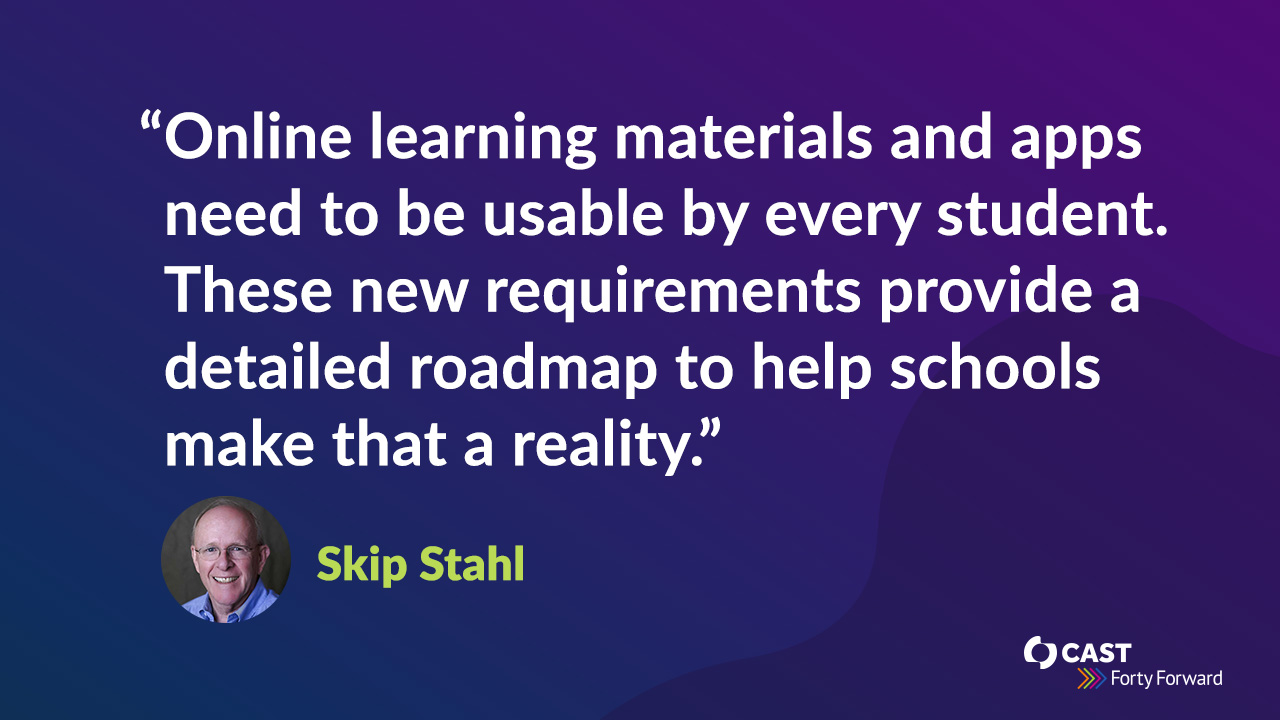Learning on the Go: ADA Title II Updates and Requirements

In April 2024, the United States Department of Justice issued a final rule requiring state and local governmental entities — including early childhood, elementary, secondary, and postsecondary institutions — to ensure web- or mobile app-based digital learning resources are appropriate for and usable by students with disabilities. This final rule details the technical requirements (WCAG 2.1 Level AA) these materials must conform to, and sets an implementation period (by 2026 or 2027), depending upon population determinants.
What does this mean for schools?
The addition of this technical specification to Title II of the Americans with Disabilities Act (ADA) builds on long-standing accessibility assumptions embedded within civil rights, special education, and copyright law. These statutes are designed to guarantee students with disabilities can acquire the same information, participate in the same activities, and enjoy the same opportunities as other students. It also requires schools to ensure students with disabilities can access web-based and mobile app-delivered information with substantially equivalent ease of use as students without disabilities. Hence, POUR: perceivable, operable, understandable and robust, the four principles of WCAG that define accessible experiences.
What materials are covered?
These regulations cover any web or app-based medium for information exchange that could impact student opportunity. For curriculum materials, this includes all web-based content management (CMS) or delivery systems, all third-party instructional content that may be embedded in a CMS; all commercial and open educational or teacher-developed resources that may be delivered online or via an app; and all online assessments. Also included are: any school/parent communication systems and resources, course registration and online grading utilities, as well as any mobile apps that offer access to the same instructional or informational resources.
Are there exceptions?
Yes. There are five specific categories of web- or app-based materials that, under certain circumstances, need not conform to WCAG 2.1 Level AA accessibility. These include:
-
Archived material
-
Legacy electronic documents
-
Third-party material not under the control of the public entity
-
Material containing personally identifying information
-
Preexisting social media posts
However, despite these exceptions, material in any of these categories is required to be provided in an accessible format if updated after the rule goes into effect or upon request.
Where to begin?
Nearly every preK-postsecondary school in this country has significant investments in both informational and instructional technologies that fall within the new accessibility regulations. In some of these settings, protocols and procedures for ensuring accessible materials and practices are already in place. In others, the legal mandates present new challenges. In either situation, a proactive strategy that addresses both the remediation of existing resources and securing new ones that are certified accessible is far more economical and accurate than attempting to retrofit digital materials on an ad hoc basis.
Places to Look for Help
The National Center on Accessible Educational Materials at CAST (AEM Center) has extensive and publicly available resources for both EdTech creators and consumers. CAST’s expertise represents more than 30 years of innovation in accessible curriculum design. From the 1995 creation of Bobby, the first WCAG-aligned web accessibility checker, to the 2005 publication and current maintenance of the National Instructional Materials Accessibility Standard (NIMAS), accessibility has served as the foundation of CAST’s UDL framework. Central to addressing the needs of students with disabilities, UDL is interwoven throughout the 2024 National Education Technology Plan as a reaffirmation of accessibility guarantees in special education and civil rights law.
The final rule’s legal mandates apply directly to state and local education agencies. To support these entities, the AEM Center has established, with field-based support, a collection of Quality Indicators for the Provision of Accessible Educational Materials and Technologies. Each of these seven basic principles is supported by one or more “Critical Components” that are designed to be actionable and measurable benchmarks of progress. Further, custom sets of Quality Indicators are provided for Early Childhood, K-12, Postsecondary, and Workforce Development settings.
Additional and extensive CAST resources extend from the core features addressed by the Quality Indicators. A sampling of these include: synchronous and asynchronous online courses, webinars, AEM Pilot (an online tool for districts to self-assess progress and curriculum materials purchasing language), and CAST Figuration (a free technical framework for building interactive websites that are accessible across devices). In addition to its array of openly available resources, AEM Center and other CAST personnel are available to consult, support and help develop inclusive educational policies, practices, and materials that conform to the legal mandates.
Beyond the AEM Center, the organization 1EDTECH has developed a field-based Accessibility Rubric for content developers to self-assess the accessibility of their products. While not designed as an accessibility conformance tool, the rubric is designed to indicate a content developer’s progress toward meeting accessibility expectations, and to provide consumers with more in-depth information than might be included in a specification-aligned checklist. Information detailing the Rubric is publicly available, and provides a helpful resource to developers new to accessibility issues and to schools seeking more in-depth information about content development.
There is a wide array of organizations, guidance documents and auditing tools focused on the accessibility of online learning materials and mobile apps. In future postings we’ll review some of these resources and the ways in which they can benefit the creation of more responsive learning materials. As EdTech materials and delivery systems proliferate across and within the nation’s schools, continued investments in inclusive design are essential to ensuring inequity is not a byproduct of innovation.
More from CAST
Celebrating 40 Remarkable Years of Educational Transformation with CAST
A Historic Milestone: Senate Resolution 723 Recognizes 40 Years of Universal Design for Learning (UDL)
Tuesday, June 4, 2024
Supporting the NEPT with CAST's Universal Design for Learning Solutions
Discover how CAST can empower your institution with inclusive education tools aligned with the National Education Technology Plan
Vetting for Accessibility with POUR
Start with these questions as you vet digital accessibility materials for accessibility.
